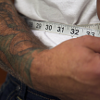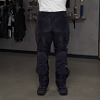Helmets, jackets, gloves, and boots get plenty of attention in the world of motorcycle gear. It’s easy to forget your pants.
Too often, pants are the last piece of protective gear a rider invests in, and that’s a bit of a problem. Should you come off the bike, there’s a decent chance that a knee or hip will contact the ground. Adding impact and slide protection to those areas makes a big difference. In addition to added protection, motorcycle pants offer other features like waterproofing, ventilation, and increased flexibility that your street clothes might not have. Let’s take a closer look at what motorcycle pants can do for you.
Like moto gear for the top half of your body, your basic choices are textile and leather.
Textile pants
If it’s not leather, it’s textile. Easy enough, right? Moto gear manufacturers use a wide variety of textile materials to add features and style to their pants. Within textile pants, you’ll find three main categories to consider: riding jeans, mesh pants, and full textile pants.

Riding jeans
Moto-specific riding jeans are a relatively new development in the industry, and they’re already one of the most popular options for today’s street riders. Plenty of folks are on and off the bike in a typical day. That’s where riding jeans come in with their casual style and hidden protection. Most riding jeans are optimized for low-speed riding or just cruising around. Think of urban riding, or a commute. (You won’t see riding jeans at the track!) A good pair of riding jeans might have knee armor and hip armor, plus some abrasion-resistant material like Kevlar built in. Riding jeans can get pretty hot, and they don’t always include armor, but for most riding around town, they’ll keep you safer than regular jeans and similarly stylin’.

Mesh pants
For hot weather riding, it’s hard to beat a pair of mesh riding pants. Like mesh jackets, these pants feature large panels of mesh to improve airflow, with far tougher materials in critical zones. Gone is the casual styling of the riding jean. In exchange, you get superior comfort, more weatherproof options, and protection appropriate for longer rides. Due to all that ventilation, you’ll want to skip these pants for any kind of cold weather riding. And keep in mind, mesh isn’t as durable as other textiles, so you’ll want to level up for true high-speed riding.

Full textile pants
Full textile pants provide the most protection and features of any textile option. This is where you’ll find true multi-seasonality, waterproofing, thermal liners, wicking materials, and more. Wanna go fast? They can better handle high-speed crashes, as well. For street or off-road use, you should be able to find a pair of full textiles to meet your exact needs. But once you’re heading to the track, it’s time to shop for leather.
Leather pants
Leather is the gold standard for protection when going fast on a motorcycle. That’s why it’s all you’ll see at any track day. Above all, leather’s durability makes it a great choice when a high-speed crash is possible. While leather jackets are found across all disciplines of riding, leather pants are almost always worn by sport riders for this reason. They are also usually worn as the bottom half of a two-piece suit.

Again, leather pants are extremely durable. They are also very hot, so plan your rides accordingly. Perforation helps somewhat. Since the vast majority of leather pants are for use on sporty motorcycles, they usually feature an aggressive pre-curve to help when riding in a tuck position. There are a few exceptions to this, primarily aimed at the cruiser market. Just be aware that sport-style leather pants are really designed for use on a limited range of motorcycles, and they may not be a good fit for other types of riding.
Pant fit
Motorcycle pants come in two basic fits: relaxed/touring and sport/race. You probably already know which one appeals to you more. An exception here would be riding jeans, which are available in a range of cuts, just like you’d find for street clothes.
Relaxed/touring fit
Designed for long days and big miles, the relaxed/touring fit is common among full textile pants. A pair of technical riding pants will often use the wider, straighter cut to fit liner systems. The pants go over top of the boots here.
Sport/race fit
Sport/race fit is exactly what it sounds like: aggressive, tight, and pre-curved to mimic your body on a sport motorcycle. These pants are designed to hold armor in place against a rider’s body so that it can do its job in the event of a crash. Sport pants should be tucked into the boot in most cases, though some exceptions are out there.
Regardless of which fit you go with, motorcycle pants shouldn’t restrict your movement too much or cause significant discomfort. When standing, the top of the armor should settle right at your knee. When you’re on the bike, it will move into place as you bend. Try your moto pants on with any gear you’ll be using to make sure it all works together. This is especially important for dirt bikers, who wear knee protection under their pants.
Pant size
By now, you should have a good idea of what style and fit you’re looking for. Time to determine your size and order some pants. “Wait, I know my pants size already,” you might say. Not so fast. Motorcycle apparel is sized differently from regular clothes. By taking a few minutes to correctly measure yourself, you’ll greatly improve your chances of ordering the right pants.

First, find a soft tape measure and a buddy. Measure your true waist (around the belly button).

Then measure the hips. Normally, this will be your widest measurement for pants sizing.

Finally, measure your inseam. That’s the distance from your crotch to your inside ankle bone. (Depending on what pants you’re ordering, it may be useful to also get a thigh measurement. Check the size chart to see if the manufacturer takes this into account.)
Checking pants for fit and size
Your new pants arrive, and it’s time to try them on. If you measured correctly and used the size chart, your pants should at least come close to a good fit. How do you tell if they’re right?

Wear the pants around the house, and try sitting on your motorcycle. (Don’t ride in the pants until you’re 100 percent sure they’re the perfect pair. We can’t accept returns on products that have been out for a ride.) The pants should be snug but not overly tight. Armor should stay in place. Work the controls and shift fore and aft in the seat. If you feel that the pants aren’t quite right, or that they might not fully protect you as intended, reach out and ask for help.
All good? Enjoy your new motorcycle pants. They should serve (and fit) you well for many miles to come.














